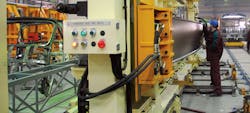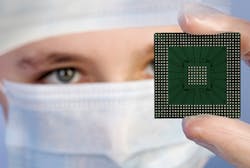Breaking into an established industry, especially one as focused as industrial technology, can be a feat that many smaller organizations find nearly impossible. Success here requires a business to provide services, software, or hardware devices that existing organizations do not already provide or do not provide in a way that addresses specific market needs. By focusing on such specific needs, new companies can create the opportunity to break through the noise of the already over-crowded automation space.
To showcase how companies are doing this effectively, we’re turning the spotlight on eight startups coming to market with technologies ranging from a software-first automation platform, virtual contract manufacturing, and industrial cybersecurity systems to metal and carbon-fiber 3D printing, and industrial analytics. These companies are making an impression with both investors and their target industrial markets, and that’s why you should know who they are.
What Bright Machines calls Software-Defined Manufacturing is a software-first approach that counters big, expensive, hardware-defined machines and robots.
In June, the company launched Bright Machine Microfactories, which combines software, machine learning, computer vision, and adaptive robotics into an automation platform. “It’s a combination of hardware and software assembled to go after the assembly and inspection problem at the back end of most factory lines,” says Amar Hanspal, Bright Machines CEO. Microfactories take advantage of artificial intelligence and a cloud-based architecture to deliver improved assembly efficiencies that continually become more intelligent and automated.
Spun off from electronics manufacturer Flex (formerly Flextronics) in mid-2018 as AutoLabs AI, Bright Machines came out of stealth mode in October last year, officially changing to its current name. At that point, the company had raised $179 million in Series A funding led by Eclipse Ventures. To date, the company has raised $200 million.
Hanspal is a former co-CEO at Autodesk—other executives come from companies such as Amazon, Flex, and Mentor Graphics, to name a few.
Traditional automation doesn’t scale fast enough to meet the growing needs of manufacturers, Hanspal says. “To change that, we need to apply software to the problem,” he asserts. “We looked at three technologies—computer vision, machine learning, and adaptive robotics—as being mature enough now to package up and attack this problem. The result of that is this product we call a software-defined microfactory.”
By the time it had officially launched Microfactories, Bright Machines had serious engagements with customers to start iterating on the technology—working with about 20 product brands on 25 production lines around the world.
Claroty supplies an industrial security platform specifically designed for operational technology (OT) and Industrial Internet of Things (IIoT) environments. The platform includes four products: Continuous Threat Detection, Secure Remote Access, Enterprise Management Console, and Security Posture Analysis. “The platform provides security teams with deep visibility into industrial control networks, real-time threat and vulnerability monitoring, network segmentation, control over employee and third-party remote access, and integration with existing security operations center, cybersecurity and network infrastructures,” said Galina Antova, co-founder and chief business development officer at Claroty.
Founded in 2014 by Amir Zilberstein, Benny Porat, and Galina Antova, Claroty emerged from stealth in 2016 and targets the oil and gas, water treatment, power and energy, automotive, mining, pharmaceutical, food and beverage, and aerospace industries, among others. The company provides a clientless interface that external users connect through and is completely segregated from the internal network. “Through this interface, network administrators can control which users are granted access to industrial control assets and for what purpose. The system enforces password management and access control policies, governs remote connections, and monitors and records remote access sessions,” said Antova.
Zilberstein and Porat both served in the elite cyber unit of the Israeli Defense Force, with Zilberstein being a previous co-founder of Waterfall Security Solutions and Gita Technologies. Prior to joining Claroty, Antova was global head of industrial security services at Siemens.
To date, Claroty has received $100 million in funding—including a Series B round of $60 million announced in June 2018. The company’s investors include Siemens, Rockwell Automation, and Schneider Electric. “It is unprecedented for three of the world’s largest industrial automation providers—who compete head-to-head—to come together in support of a common OT security company,” Antova said.
Other key investors include Bessemer Venture Partners, Temasek (the sovereign wealth fund of Singapore), BMW iVentures, Mitsui, Innovation Endeavors, and Energy Ventures.
Corvex Connected Safety got its start creating an open platform for personal protective equipment (PPE) manufacturers to develop smart PPE in which sensors compare what workers are actually wearing vs. what the safety plan calls for in that area. The platform has since evolved into a digital transformation for frontline workers, engaging them in a full operational excellence picture that improves productivity and reduces employee turnover rates.
“There’s this massive gap in technology for frontline workers, specifically in manufacturing, but as well in construction and oil and gas, and everywhere else, for that matter,” says Ted Smith, president and CEO of Corvex. “There’s no technology available to them. And in a lot of places, they can’t have their personal mobile device with them because it’s a safety hazard.”
Corvex was founded about three years ago by Smith, who has a background in enterprise software, and Joe O’Brien, chairman of the board, who comes from the PPE industry. The initial funding for Corvex came from several PPE vendors, and they have since received injections from new partnerships with MCR Safety and Ergodyne. A partnership with management consulting firm BEworks focuses on behavior-based methods to improve safety.
A key component of Corvex’s technology is the smart PPE where the company got its start. A module called Site Awareness locates a worker based on what manufacturing zone they’re in. It can then push content to them based, for example, on known hazards in that area, specific PPE or training required for that area, or any other content the client might want to provide to its workers. Another component is the Observation Module, which enables workers to make observations about safety, quality, or productivity and escalate issues quickly.
Brothers Dave and Nate Evans were going down two very different career paths—Dave as a mechanical engineer and Nate as a startup advisor for a boutique investment firm. Dave, the first hire at Ford’s Silicon Valley Lab, grew frustrated by the labor-intensive process of sourcing quality prototypes and the long wait times for parts. Meanwhile, Nate was inspired by the advertising market’s use of automated networks of websites to sell ad space. Putting their heads together, the duo saw an opportunity to maximize manufacturing machines that went largely unused, similar to how ad tech companies ensure ad space is sold.
In 2013, the Evans brothers launched Fictiv, a virtual contract manufacturer that provides an online platform to help companies bring hardware products to market faster by tapping into the latent capacity of more than 200 small manufacturing facilities across the U.S. and China.
The Fictiv online platform uses workflow, algorithms, and data models to open up access to unused manufacturing capacity, streamline time-to-market, minimize materials requirements, and reduce costs through efficient design. “Engineers who are working on product development can upload 3D models of a design and we use machine learning to give them instant quotes on pricing as we find a manufacturing partner in our global network who is best suited [for the job] with the latent capacity,” said Mike Geyer, vice president of marketing and business development at Fictiv.
Fictiv’s capability is becoming increasingly important in the global industrial market, especially as manufacturers are preparing to get hit with tariffs as high as 25% as a result of the U.S. and China trade war. “Companies manufacturing through the traditional supply chain are locked in…and they are frantically trying to find alternatives, so I see a period of rapid growth for us,” said Geyer.
That growth is supported by investors. In March 2019, Fictiv announced that it closed a $33 million Series C funding round to accelerate its transformation of contract manufacturing into a global digital ecosystem that enables fast, flexible hardware product development and production. Led by G2VP, Accel, Bill Gates, Intel Capital, Sinovation, Tandon Group, and new investor Mitsui & Co., this round brought Fictiv’s total investment to $58 million.
Founded in 2013, Markforged supplies metal and carbon-fiber 3D printers that produce parts tough enough for end-use in automotive, oil and gas, aerospace, and harsh factory environments. Engineers and designers use Markforged metal and composite printers for tooling, fixtures, functional prototyping, and high-value end-use production.
Founder and CEO Greg Mark said Markforged differentiates itself in the market through its use of artificial intelligence (AI). The company’s flagship technology, Blacksmith, is “the first AI-powered software that makes manufacturing machines ‘aware’ so they can automatically adjust programming to ensure every part is produced as designed,” said Mark.
The company positions its product as a key factor in labor and cost savings on non-revenue generating parts like tooling and fixtures. “Previously, critical replacement parts needed along the factory line were shipped in from outside vendors,” said Mark. “This would halt activity entirely as engineers had to wait for those replacements to arrive—directly affecting production timelines and, therefore, revenue. With Markforged, engineers can create any and all replacements in-house.”
Markforged has received $136.8 million across five rounds of funding, according to Mark. Key investors in the company include Summit Partners, Porsche Automobil Holding, Next47 (the investment arm of Siemens), and M12 (Microsoft’s venture fund), among others. “At this point, Markforged is extremely cash-flow efficient. Our Series D round was meant to help expedite our already massive growth in 2018,” said Mark. “We experienced a three-year growth rate of 12,687% between 2014 and 2017, tripled in size, shipped close to 3,000 printers—more than any other industrial printing company—and have surpassed more than 10,000 users.”
Competing in the very crowded industrial analytics software market, Seeq differentiates itself with “time series data analytics and the domain expertise of our employees in successfully applying Seeq to specific use cases,” said Michael Risse, Seeq’s chief marketing officer. “Seeq enables users to find insights quickly, with ROI measured in hours and days rather than weeks or months,” he said.
The software is an advanced analytics application for deployment on premise or in the cloud. It can also be licensed as a software-as-a-service (SaaS) application. Seeq’s Workbench and Organizer interfaces are based on HTML 5 and can run in any modern browser. Risse said the Seeq server can run anywhere, and Seeq connects to both time series (historian, open source, cloud services) and relational (SQL-based) data sources.
Seeq tends to focus on the process manufacturing vertical, with customers in both continuous and batch operations. However, Risse noted that Seeq also has customers in discrete manufacturing, where the software is used for remote monitoring and predictive analytics.
The company was founded in 2013 by Steve Sliwa (CEO) and Brian Parsonnet (CTO). Parsonnet has 30 years of industry experience at Loveland Controls, Honeywell, and Ice Energy, and Sliwa has served as president of Embry-Riddle University in addition to multiple CEO experiences at several startups, including Insitu. Sliwa and Parsonnet were joined by eight other founding partners with experience in software and automation.
Seeq has completed two rounds of funding rounds—Series A, led by Second Avenue Partners in July 2013, in which it raised $11 million; and Series B, led by Altira Group, in which Seeq garnered an additional $23 million in July 2018. The Series B funding was focused on oil and gas startups and included Chevron Technology Ventures and Next47 (the investment arm of Siemens), with additional participation by Series A investors.
“A year ago, Seeq had 50 employees. As of mid-July 2019, we had about 100,” said Risse. In the 2019 Inc. 5000 fastest growing, privately-held companies list, Seeq was ranked #369 overall, #49 in software, and #7 in Seattle.
As artificial intelligence (AI) takes off, SparkCognition is working with companies to help them analyze complex data, empower decision-making, and improve productivity. Its AI platforms help protect and optimize assets, unlock unstructured data, accelerate data science, and power security systems.
In the oil and gas industry, SparkCognition has been providing a significant amount of predictive maintenance for refineries and offshore oil platforms and is now getting into liquefied natural gas trains, according to Philippe Herve, vice president of oil and gas solutions for SparkCognition. Though oil and gas is a traditionally risk-averse industry, producers have generally been jumping into AI. “They’ve accepted that predictive maintenance using artificial intelligence is the way to go,” he says.
Customers have been hesitant to give away their competitive secrets by allowing public announcements. But SparkCognition is doing much the same thing with other super majors, Herve says, as it’s doing with Aker BP, which went public in March with its AI collaboration. As part of its Cognitive Operation initiative, Aker BP deployed SparkPredict for advanced predictive maintenance capabilities on its offshore production platforms.
Though predictive maintenance is a clear go-to project for AI, oil and gas producers are also pursuing capabilities around optimizing drilling operations and other processes. “Our platform can predict drilling dysfunction so the drilling team can mitigate the problems,” Herve says.
Founded by Amir Husain in 2014, SparkCognition received $706,700 in grant funding from the U.S. Department of Energy in late 2017. Series B funding—which closed at the end of 2017—raised $56.5 million, led by Verizon Ventures, with other significant investors including Boeing, Invenergy Future Fund, and CME Ventures.
The process for procuring and managing capital assets hasn’t changed much over the years. What has changed is the massive amounts of data generated from these machines, which can be used to help provide options for how equipment is procured, serviced, warrantied, and operated. But to do that, machine data must be directly connected to accounting.
Enter Steamchain, an automated business process engine that leverages blockchain technology to use industrial machine data to execute financial transactions. The technology—called the Secure Transaction Engine for Automated Machinery (S.T.E.A.M)—is creating new business models for OEMs around equipment performance, outcome-based warranties, usage-based financing, and automated contract management.
Michael Cromheecke, CEO of Steamchain, says it’s a perfect time for Steamchain technology. “Why would an end user want to buy a machine from a company that doesn’t have a financial interest in how it performs post-delivery? And why would an OEM, that has confidence in their equipment, not want to generate revenue from their ability to outperform their competition?” he asks. Cromheecke co-founded the company with Tomas Tichy in 2017.
Cromheecke and Tichy came up with the idea for Steamchain from their many years of mitigating equipment issues between OEMs and end users.
With Steamchain’s Secure Transaction Engine, the OEM can deliver the equipment in a Machine-as-a-Service (MaaS) model, a fee-based approach in which the OEM is selling the ability to achieve an outcome. Blockchain technology is used to manage the transactions with its immutable record of data that is resilient (it can’t be rescinded), objective (it is the data collected off the machine), timely (data is immediately placed into the blockchain for all parties to access), and transparent (everyone sees it).
Steamchain has received support from a combination of industry executives acting as angel investors, as well as some early stage venture capital firms and leading corporate venture capital organizations, with additional support from Northwestern Mutual’s Cream City Labs.
Companies in this Article

Leaders relevant to this article:



